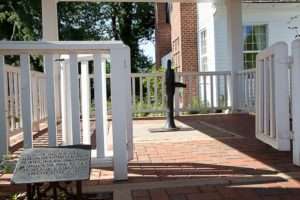The large earthen mound known as the Florence Indian Mound was the heart of a large prehistoric cultural center that dominated this section of the Tennessee River Valley thousands of years ago. An early 1800s map showed the mound as quadrilateral in shape with its four corners corresponding to the four cardinal directions. It featured an eight to ten foot high earthen embankment that partially encircled it from river bank to river bank. The University of Alabama conducted excavations of the mound and determined that it was originally built between AD 100 and 500, during the Woodland Stage. These investigations also found that 1,000 years later, people associated with the Mississippian Stage added more earth to the summit and continued to use the mound as a cultural center.
The Woodland peoples who originally built the mound belonged to what has been termed the Copena Mortuary Complex – a group that built mounds and were part of an extensive trade network. The Copena were associated with a larger cultural group named Hopewell that dominated the Ohio Valley and surrounding regions. Their influence extended from the Appalachian Mountains to the western end of the Tennessee Valley to the Great Lakes.
“Copena” derives its name from the combination of two words for items commonly found in Copena sites: copper and galena (lead sulfide). Copper was likely traded from the upper Midwest and galena from the Upper Mississippi Valley in the area of Wisconsin, Illinois, and Iowa. Copena people traded these raw materials extensively, and used them to create jewelry and other fine items that they used in life and also often buried with their dead.
The later reuse of the mound by Mississippian peoples around AD 1200-1450 is not surprising. The mound and surrounding embankment would have been a prominent feature of the floodplain and a well-known landmark that allowed Mississippian peoples to take advantage of the mound for their own ceremonies and activities.
The mound and surrounding area have been significantly impacted by development. In the late 1800’s a man built a house on the mound’s summit and planted gardens on the sides of the mound, which destroyed much of the evidence of the Mississippian occupation. In the early 1900’s, industrial development adjacent to the mound also destroyed the surrounding embankment. While these impacts represent a loss of information that could inform our understanding of this site, the Florence Mound still provides us with significant information about the area and the people who lived in the Tennessee Valley centuries ago.
This site is very important to numerous Southeastern indigenous tribes who assert an ancestral connection with those who built and occupied Alabama’s ancient mounds. The earthwork landscapes and the objects and information recovered from them reveal a rich cultural tradition that still thrives today among these tribes. Our indigenous mound sites represent a heritage for all Alabamians to cherish, and it is important that we protect and preserve them for future generations.




